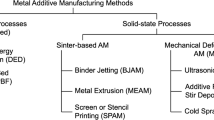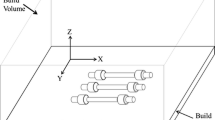Abstract
In order to obtain accurate tube hydroforming (THF) simulation results, one of the important inputs in the finite element model (FEM) of the process is the mechanical response of the material during THF. Generally, the mechanical response is defined by the stress–strain behavior that can be determined from tensile testing of the specimens extracted either from the sheet used for roll forming of the tubes or directly from the tubes. More recently, free expansion testing has been used to characterize the mechanical response of the material for hydroforming applications. The free expansion test can emulate process conditions similar to those found during THF, and as such, can be used to obtain reliable and accurate information on the mechanical response/properties of the tubular material. The aim of this research is to present an approach for evaluating the stress–strain behavior of different materials using a 3D deformation measurement system in conjunction with an analytical model. Here, to characterize the mechanical response of the materials, free expansion and tensile testing were used for austenitic stainless steel types 321 (SS 321) and 304L (SS 304L), INCONEL® alloy 718 (IN 718), and aluminum alloy 6061 in the annealed “0” temper condition (AA 6061-0). The mechanical response of each material, measured through free expansion testing of tubular forms, was compared to the respective stress–strain behavior determined from the uniaxial tensile test using ASTM E8 geometry specimens extracted from the tubes. For each material studied in this work, the two flow stress behaviors were distinct, indicating that the test method can have a noticeable effect on the mechanical response. Finite element analysis (FEA) of the free expansion of each material was also utilized to simulate the THF process with the flow stress curves obtained experimentally; the predicted expansion and burst pressure results were close to the experimental data indicating that the approach developed and described in this work has merit for characterizing the mechanical response of aerospace alloys for hydroforming applications.
Similar content being viewed by others
References
Hartl C (2005) Research and advances in fundamentals and industrial application of hydroforming. J Mater Process Technol 167:383–392
Lang LH, Wang ZR, Kang DC, Yuan SJ, Zhang SH, Danckert J, Nielsen KB (2004) Hydroforming highlights: sheet hydro forming and tube hydro forming. J Mater Process Technol 15:165–177
Ahmed M, Hashmi MSJ (1997) Estimation of machine parameters for hydraulic bulge forming of tubular components. J Mater Process Technol 64:9–23
Vollertsen F, Plancak P (2002) On possibilities for the determination of the coefficient of friction in hydroforming of tubes. J Mater Process Technol 125-126:412–420
Koç M, Altan T (2002) Prediction of forming limits and parameters in the tube hydroforming process. Int J Mach Tool Manuf 42:123–138
Yang B, Zhang WG (2006) Analysis and finite element simulation of the tube bulge hydroforming process. Int J Adv Manuf Technol 29:453–458. doi:10.1007/s00170-005-2548-6
Koç M, Aue-u-lan Y, Altan T (2001) On the characteristics of tubular materials for hydroforming: experimentation and analysis. Int J Mach Tool Manu 41:761–772
Sokolowski T, Gerke K, Ahmetoglu M, Altan T (2000) Evaluation of tube formability and material characteristics: hydraulic bulge testing of tubes. J Mater Process Technol 98:34–40
Song WJ, Kim J, Kang BS (2007) Experimental and analytical evaluation on flow stress of tubular material for tube hydroforming simulation. J Mater Process Technol 19:368–371
Song WJ, Heo SC, Ku TW, Kim J, Kang BS (2010) Evaluation of effect of flow stress characteristics of tubular material on forming limit in tube hydroforming process. Int J Mach Tool Manuf 50:753–764
Hwang YM, Wang CW (2009) Flow stress evaluation of zinc copper and carbon steel tubes by hydraulic bulge tests considering their anisotropy. J Mater Process Technol 209:4423–4428
Saboori M, Champliaud H, Gholipour J, Gakwaya A, Savoie J, Wanjara P (2013) Effect of material model on finite element modeling of aerospace alloys. Key Eng Mater 554-557:151-156
Fuchizawa S, Narazaki M (1993) Bulge test for determining stress–strain characteristics of thin tubes. Advanced Technology of Plasticity, 4th ICTP 488-493
Hwang YM, Lin YK (2002) Analysis and finite element simulation of the tube bulge hydroforming process. J Mater Process Technol 125–126:821-825
Hwang YM, Lin YK, Altan T (2007) Evaluation of tubular materials by a hydraulic bulge test. Int J Mach Tool Manuf 47:343–351
Bortot P, Ceretti E, Giardini C (2008) The determination of flow stress of tubular material for hydroforming application. J Mater Process Technol 203:381–388
Aguir H, BelHadjSalah H, Hambli R (2011) Parameter identification of an elasto-plastic behaviour using artificial neural networks–genetic algorithm method. J Mater Design 32:48–53
Zribi T, Khalfallah A, BelhadjSalah H (2013) Experimental characterization and inverse constitutive parameters identification of tubular materials for tube hydroforming process. J Mater Design 49:866–877
Hill R (1979) Theoretical plasticity of textured aggregates. Math Proc Camb Philos Soc 85:179–191
Saboori M, Gholipour J, Champliaud H, Gakwaya A, Savoie J, Wanjara P (2013) Development of an Inverse Method for Material Characterization, Materials Science and Technology: Symposium on Advances in Hydroelectric Turbine Manufacturing and Repair, Montreal, Canada, October 27-31
Anderson M, M.S.c. Thesis, (2010) Dept. of Mechanical Engineering, École de technologie Supérieure, Montreal, Canada
Abrantes JP, Szabo-Ponce A, Batalha GF (2005) Experimental and numerical simulation of tube hydroforming (THF). J Mater Process Technol 164–165:1140–1147
ASTM Committee E-28.11. (2011) Standard test method for tension testing of metallic materials. ASTM E8M-04
Belytschko TLI, Tsay CS (1984) Explicit algorithms for the nonlinear dynamics of shells. Comput Methods Appl Mech Eng 42:225–251
Author information
Authors and Affiliations
Corresponding author
Rights and permissions
About this article
Cite this article
Saboori, M., Champliaud, H., Gholipour, J. et al. Evaluating the flow stress of aerospace alloys for tube hydroforming process by free expansion testing. Int J Adv Manuf Technol 72, 1275–1286 (2014). https://doi.org/10.1007/s00170-014-5670-5
Received:
Accepted:
Published:
Issue Date:
DOI: https://doi.org/10.1007/s00170-014-5670-5




